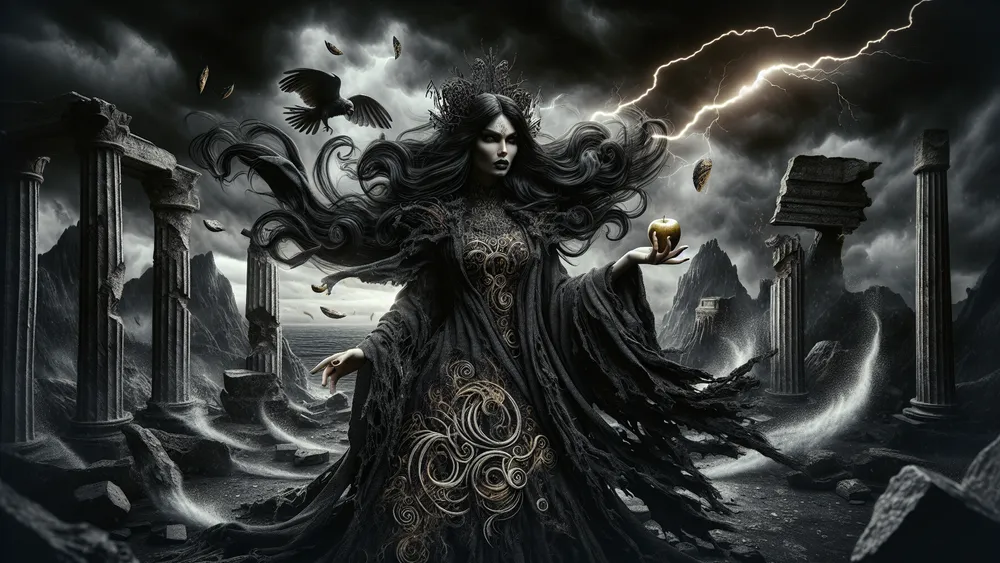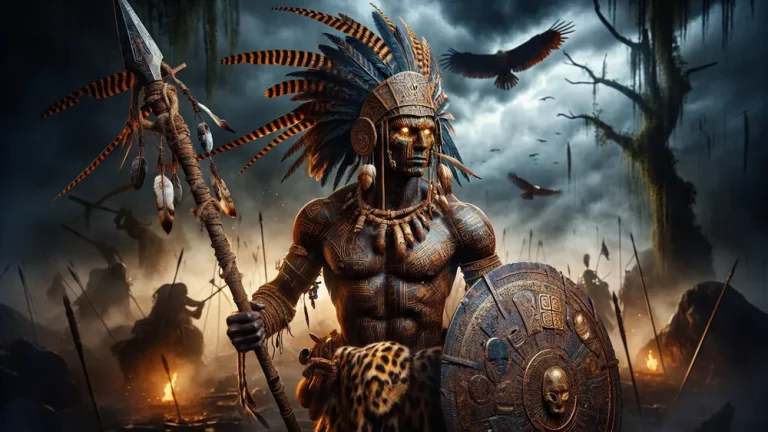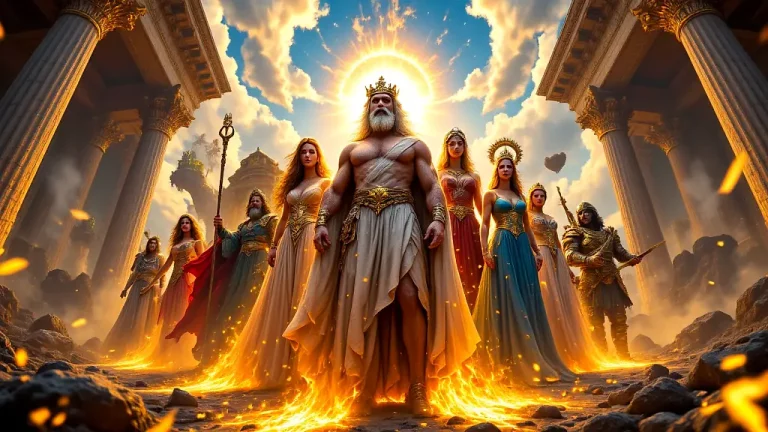Eris: Greek Goddess Of Strife, Discord, And Chaos
In the huge web of Greek mythology, not many characters are as interesting and tricky as Eris, the goddess of strife, stress, and chaos. Think of someone who loves creating problems, a person who enters a room and right away makes stress and arguments–that is Eris in the gods’ world. Her presence is noticed in many important and dramatic ancient Greek stories, where what she does often leads to big and long-lasting effects.
Key Points:
- Eris is the Greek goddess of strife, discord, and chaos, known for causing problems.
- She is the daughter of Nyx (Night) and Erebus (Darkness), and she is often in the background of many Greek myths.
- Eris plays a key role in the Judgement of Paris, which led to the Trojan War, by throwing a golden apple to cause a fight between the goddesses Hera, Athena, and Aphrodite.
- Her influence is also seen in other stories, such as the myth of the Argonauts and the tale of Heracles, where she stirs up conflict.
- Eris is usually linked with symbols like the golden apple, the snake, and the dagger, all of which represent aspects of conflict and deceit.
- In ancient Greek art and stories, Eris is often shown as a wing-wearing figure or as a disrupter of peace.
- While she didn’t have a huge following in ancient Greece, her influence was recognized in situations tied to conflict and competition, and she was both feared and respected.
When you dig into the stories about Eris, we will uncover her roots, her place among the gods of Olympus, and her lasting effect on both the divine and human worlds. Even if you are new to these stories or know them well, looking into Eris will give you a full understanding of who she is and the chaos she brings.
Eris: Overview and Key Facts
| Key Point | Description |
|---|---|
| Name | Eris |
| Position | Goddess of Strife, Stress, and Chaos |
| Parents | Her parents are Nyx (Night) and Erebus (Darkness) |
| Siblings | Thanatos (Death), Hypnos (Sleep), Nemeses (Payback), and others |
| Signs | Golden Fruit, Snake |
| Major Stories | Paris’s Choice, The Battle of Troy |
| Roman Name | Discordia |
| Images in Art | Often seen as a dark, winged figure or a lovely but harmful woman |
| Worship and Events | Hardly anyone worships her; there aren’t any big festivals |
| Cultural View | Seen as a troublemaker, both feared and recognized for her strength |
Getting to Know Eris
To really understand the nature of Eris and how she affects Greek mythology, you need to look into where she came from, what she does among the gods, and the stories that talk about her.
Who is Eris?
Eris, in Greek mythology, is the goddess of strife, discord, and chaos. She is often seen as a person who enjoys causing conflict and problems. Think of someone who likes making fights and messes in a group – that’s Eris among the gods.
She is the daughter of Nyx (Night) and Erebus (Darkness), which means she’s one of the oldest gods in the ancient Greek stories. Unlike the more famous gods on Mount Olympus, Eris does not live there but still has an essential role in many stories. Most times, her presence is in the background, quietly influencing things and causing trouble, making her a vital but hard-to-notice figure in Greek mythology.

Eris, the goddess of strife and chaos in Greek mythology, enjoys causing conflict, being one of the oldest gods with a crucial but often overlooked role in stories, quietly stirring trouble in the background.
What Eris Does in Greek Myths
Eris is best known for her role in the myth of the Judgement of Paris, which led to the Trojan War. Imagine a social gathering where everyone gets along, and then someone brings up a topic that causes fights and problems. This is exactly what Eris did at the wedding of Peleus and Thetis. Not invited to the party, she threw a golden apple inscribed with “To the fairest,” among the goddesses.
This started a big argument between Hera, Athena, and Aphrodite. This small act set off a chain of events that ended in the Judgement of Paris. Paris of Troy had to decide which goddess deserved the apple. He chose Aphrodite, who promised him Helen, the most beautiful woman in the world, which led to the Trojan War.
Furthermore, Eris’ influence goes beyond this one myth. She appears in other stories that involve conflict and chaos. It’s like throwing a stone into a calm pond. The stone creates ripples that disturb the peace. Some important events influenced by Eris include:
- The Judgement of Paris: Her golden apple caused a fight among the goddesses, leading to the Trojan War.
- The Trojan War: Her first act of causing discord set the stage for this famous conflict in Greek mythology.
- Other Myths: Eris often causes strife and discord among gods and people.
Through these stories, Eris embodies the unpredictable and often destructive nature of chaos. This makes her a vital figure in Greek mythology.
Stories About Eris
To get to know Eris’ effect on Greek mythology, let’s look at some of the biggest stories where she plays a vital role.
The Judgement of Paris
The story of the Judgement of Paris begins with the wedding of Peleus and Thetis, a big party where many gods and goddesses were there. However, Eris, the goddess of strife, was not invited. In retaliation, she made a plan to create discord among the attendees. She threw a golden apple inscribed with “To the fairest” into the middle of the celebration.
Think about an award being thrown into a group, with everyone wanting to get it – this is the chaos Eris intended to create. The apple immediately got the attention of three powerful goddesses: Hera, Athena, and Aphrodite, each thinking she deserved to be called the fairest.
To settle the argument, the goddesses went to Zeus, the king of the gods, who decided to give the decision to Paris, a prince of Troy known for being fair. Paris was promised rewards by each goddess if he chose her.
Hera offered power and kingship, Athena promised wisdom and military success, and Aphrodite said she would give him the love of the most beautiful woman in the world, Helen of Sparta. Paris gave the golden apple to Aphrodite because of her promise about Helen. This decision started a series of events that led to Helen’s abduction and the Trojan War. The importance of this myth in Greek culture is huge.

It shows how small actions can have big consequences. When Eris threw the golden apple, it started a fight and also led to one of the most famous conflicts in Greek mythology. The Judgement of Paris means the themes of vanity, desire, and the mix of fate and free will are all tied together, making it a cornerstone in Greek stories.
Eris and the Trojan War
Eris’ part in the Trojan War goes beyond just starting things with the Judgement of Paris. Her effect appears as a starter that led to a series of events in one of the most famous conflicts in Greek stories. When Paris took Helen, the wife of Menelaus, the Greek kings united under Agamemnon to start a big journey against Troy.
Eris’ first action of causing problems grew into a big war involving both gods and people. The gods themselves picked sides, with Hera, Athena, and Poseidon backing the Greeks, while Aphrodite, Apollo, and Ares helped the Trojans. This divine conflict added layers of trouble and confusion to the fight, making it more than just a war between men but also a cosmic struggle influenced by the gods’ whims and rivalries.
The long-term effects of Eris’ actions were deep and widespread. The Trojan War lasted ten years and led to big losses and destruction. Heroes like Achilles, Hector, and Patroclus met their tragic ends, and Troy was finally burned down.
The war also had lasting effects for those who survived; for example, Odysseus‘ trip home took an extra ten years full of problems, as told in Homer’s “Odyssey.” Eris’ role in starting the war means the dangerous power of trouble and fighting, showing a warning about the wide-reaching impacts of small acts of chaos.
Other Myths and Legends
Beyond the Judgement of Paris and the Trojan War, Eris is in other myths where she always brings chaos and trouble. For example, in the myth of the Argonauts, Eris caused a fight among the crew, which made their journey for the Golden Fleece harder. In another story about Heracles, Eris started a conflict between him and the river god Achelous over Deianara.
Eris acts like someone who keeps causing problems, always finding a way to mess up peace, no matter the situation. Her actions are a reminder of the unpredictable and often destructive nature of trouble, making her a lasting figure in Greek stories.
Eris consistently stirs up chaos and conflict, disrupting peace in various myths involving the Argonauts and Heracles, symbolizing the unpredictable and destructive nature of trouble in Greek tales.
Symbols and How Eris is Shown
To understand Eris’ role in Greek mythology, it’s important to see the symbols linked with her and how she is shown in art and books.
Symbols Linked to Eris
Eris is often connected with several symbols that capture her essence as the goddess of conflict and trouble. The most well-known of these is the golden apple, which she used to start the Judgement of Paris. This apple, with “To the fairest” written on it, is like a disputed prize that starts competition and jealousy among its competitors. Another symbol linked to Eris is the snake, which stands for deceit and treachery, much like how a snake can quietly and suddenly strike. These symbols aren’t just random; they carry meanings tied to Eris’ traits and impact in myths. Here are the main symbols related to Eris:
- Golden Apple: Stands for conflict and competition, famously used by Eris to trigger the Judgement of Paris.
- Snake: Stands for deceit and treachery, showing Eris’ ability to make unexpected trouble.
- Dagger: Often linked with conflict and fighting, showing the violent sides of discord that Eris brings.
These symbols help to mean the complex nature of Eris and her lasting impact on Greek mythology.
How Eris is Shown in Art
Eris appears in different kinds of old Greek art and stories, often showing chaos and trouble. In ancient paintings on vases, she is sometimes shown as a winged figure, which means her quick and unpredictable behavior.
For instance, on the François Vase, Eris appears among the gods at the wedding of Peleus and Thetis, holding the well-known golden apple that would lead to the Judgement of Paris. Additionally, in stories like Hesiod’s Theogony, Eris appears as a force that brings conflict and trouble among both gods and humans.
Her appearance in these artistic and written works is like a bringer of problems, similar to how a storm cloud on the horizon means an approaching storm. These depictions help to mean the widespread and disruptive effect of Eris in Greek stories.
Eris in Ancient Greek Life
Knowing how Eris is seen in art and stories helps see her part in the daily and religious lives of ancient Greeks.
Worship and Festivals
In ancient Greece, the worship of Eris wasn’t as important as that of other gods, but she still had an essential place among the group of gods because of her connection to strife and conflict. Unlike gods who had grand temples and big rituals, people called upon Eris in situations where conflict and competition were present.
For example, during wars or political unrest, offerings might be made to Eris to either calm her or to ask for her help in favor of one side. There were no big festivals dedicated only to Eris, but she was part of many rites and ceremonies that involved other gods, mainly those linked with war and conflict, like Ares.
This can be like how a community might look up to and fear a strong person who can bring both chaos and order, making sure they stay on her good side to avoid her anger.
How Greeks Saw Eris
Seeing Eris as both scary and respected, the ancient Greeks had a complex view of her. Similar to a strong storm, Eris meant necessary change and big mess. Being scared of her because of her ability to cause conflict and discord. For example, myths like the Judgement of Paris leading to the Trojan War make this clear. But she was also respected for driving competition and progress, since strife can mean growth.

This made Eris very important in Greek culture, showing the unpredictable nature of conflict that can both destroy and create. Her stories influenced many parts of Greek life: how they saw human nature, approached war, and handled competition.
Comparing Eris with Other Gods
It’s useful to compare Eris with gods from other cultures to understand Eris’ special part in myths.
Eris vs. Discordia (Roman Mythology)
Eris and Discordia are basically two versions of each other, standing for strife and discord in Greek and Roman mythology, each. While Eris is known for her part in the Judgement of Paris and the Trojan War, Discordia shows similar traits in Roman stories. Both gods often start conflicts, but their cultural settings have slight differences. For instance, Eris’ actions are tied to specific tales like the golden apple event.

On the other hand, Discordia’s impact is more broad in Roman literature, symbolizing civil strife and political problems. To explain, Eris might be seen as a specific thunderstorm causing a historic flood, while Discordia can represent the general idea of stormy weather that disrupts daily routine.
To make these comparisons clearer, let’s examine a table showing their similarities and differences:
| Aspect | Eris (Greek Mythology) | Discordia (Roman Mythology) |
|---|---|---|
| Role | Goddess of Strife and Discord | Goddess of Strife and Discord |
| Key Myth | Judgement of Paris, Trojan War | General symbol of civil strife |
| Cultural Significance | Specific myths and events | Generalized influence in literature |
| Depiction | Often depicted with a golden apple | Shown with symbols of conflict |
| Influence | Causes specific conflicts directly | Represents larger societal discord |
By examining this table, you can see that while Eris and Discordia share many traits, their roles and representations fit their own mythological traditions.
Eris and Discordia are similar as gods symbolizing conflict but have slight differences in how they are represented in Greek and Roman mythology, with Eris being more linked to specific stories like the golden apple event and Discordia representing broader civil strife in Roman literature.
Eris vs. Loki (Norse Mythology)
Eris and Loki, both representing chaos and trouble, have different parts in their mythologies. Eris, the Greek goddess of strife, means conflict. She plays key parts like in the Judgement of Paris, causing the Trojan War. Her actions directly cause discord among gods and humans. But Loki, the Norse god of mischief, is complex.
He doesn’t just cause chaos but tricks and deceives too. What’s different, Loki’s mischief can cause harm or unexpected good things, making him more ambiguous than Eris. In their mythologies, both are crucial. Eris’ actions cause big events like the Trojan War, central in Greek mythology. Her impact is often large-scale, causing conflict and change.

On the other hand, Loki is in many myths, from world creation to its end in Ragnarok. His tricks sometimes help gods reach their goals. For instance, Loki’s trickery gets powerful items like Thor’s hammer, Mjölnir. This makes Loki more multifaceted than Eris, who mainly causes discord.
Pantheon of Greek Mythology Gods
The Greek pantheon is a large group of gods, each with their own special qualities, stories, and parts in myths. Starting with Zeus, the king of the gods, and including Hermes, the messenger, every god and goddess adds to the complex mix of Greek myths. If you’re interested in exploring the full list of all Greek Gods, you can find it here.
This resource gives detailed information on each god, which helps you understand their importance and connections in the pantheon.
FAQs
1. Who are the parents of Eris?
The parents of Eris are typically considered to be Nyx (Night) and, in some accounts, Erebus (Darkness).
2. What is the significance of the golden apple in Eris’ mythology?
The significance of the golden apple in Eris’ mythology lies in its role as the catalyst for the Judgement of Paris, which ultimately led to the Trojan War.
3. How is Eris depicted in ancient Greek art?
How Eris is depicted in ancient Greek art often shows her as a winged figure or a woman in a state of agitation, symbolizing strife and discord.
4. Are there any modern festivals or practices that honor Eris?
Modern festivals or practices that honor Eris are rare, but some contemporary groups, such as Discordianism, celebrate her influence.







